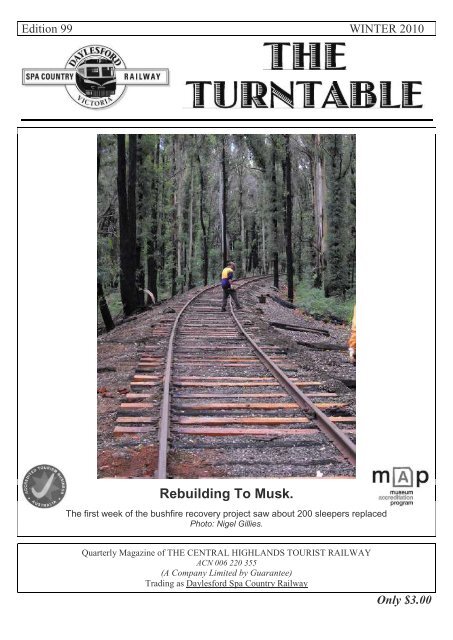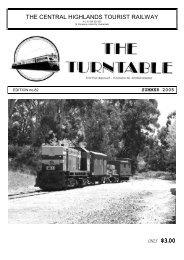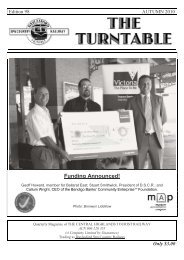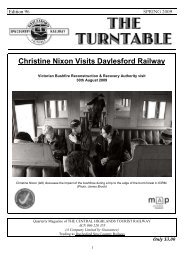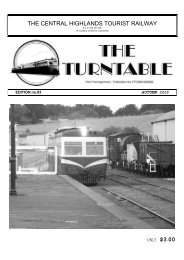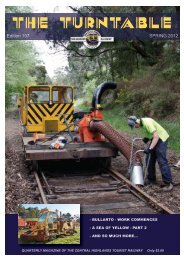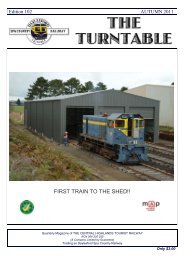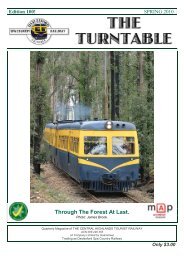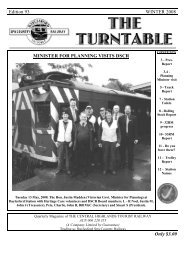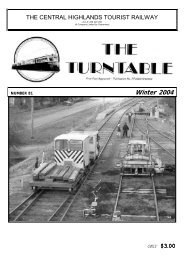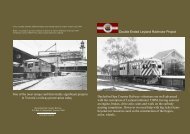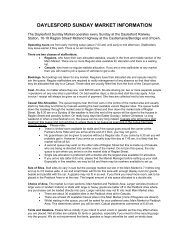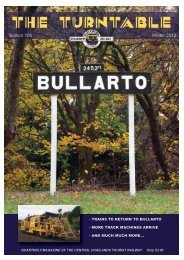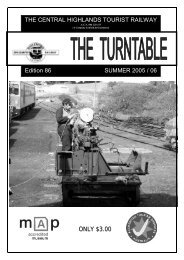Download The Turntable - Winter 2010. - Daylesford Spa Country ...
Download The Turntable - Winter 2010. - Daylesford Spa Country ...
Download The Turntable - Winter 2010. - Daylesford Spa Country ...
- No tags were found...
Create successful ePaper yourself
Turn your PDF publications into a flip-book with our unique Google optimized e-Paper software.
Edition 99 WINTER 2010Rebuilding To Musk.<strong>The</strong> first week of the bushfire recovery project saw about 200 sleepers replacedPhoto: Nigel Gillies.Quarterly Magazine of THE CENTRAL HIGHLANDS TOURIST RAILWAYACN 006 220 355(A Company Limited by Guarantee)Trading as <strong>Daylesford</strong> <strong>Spa</strong> <strong>Country</strong> RailwayOnly $3.00
ROAD NO. DESCRIPTION ENTERED SERVICE STATUSKS 35 KS 531 GANG MOTOR 1920‟s Stored.KS 36 KS 531 GANG MOTOR 1920‟s Stored.KS 130 KS 531 GANG MOTOR 1920‟s Stored.KS 269 KS 531 GANG MOTOR 1920‟s Stored.SA 1 SOUTH AUSTRALIAN GANG MOTOR - Stored.[ unknown ] KS 531 GANG MOTOR 1920‟s Stored.[ unknown ] KS 531 GANG MOTOR 1920‟s Stored.[ unknown ] FAIRMONT M19 TROLLEY (NSWGR) 1940‟s Stored (incomplete).Track Machines6.43.022 TAMPER SLEEPER RENEWER SCARIFIER 1981 Operational6.44.006 COMENG TIE HANDLING CRANE 1970‟s Operational.6.45.002 COMENG TIE BED SCARIFIER 1970‟s Operational.6.52.017 ELECTROMATIC JUNIOR UDM TAMPING MACHINE 1966 Operational.DSCR-01 JCB 3CX-4 BACKHOE LOADER 1983 Operational.DSCR-02 INTERNATIONAL AB 160 4x4 TIPPER TRUCK 1964 Operational.TC 1 TAMPER TIE HANDLING CRANE 1980‟s Awaiting accreditation.6.43.007 COMENG TIE INSERTER 1970‟s Operational- stored offsite.6.45.006 COMENG TIE BED SCARIFIER 1970‟s Awaiting accredit - stored offsite.6.35.136 COMENG MULTI SPINDLE BORER 1970‟s Stored pending restoration.6.48.005 COMENG SPIKE DRIVER 1970‟s Stored pending restoration.6.43.021 COMENG TIE RENEWER SCARIFIER (leased) 1970‟s Stored.EXT 1 GEMCO TIE EXTRACTOR 1980‟s Stored.TC 2 GEMCO TIE HANDLING CRANE 1980‟s Stored.6.43.004 COMENG TIE INSERTER 1970‟s Stored (incomplete).6.43.023 TAMPER SLEEPER RENEWER SCARIFIER 1981 Stored (incomplete)6.47.003 COMENG SPIKE PULLER (leased) 1970‟s Stored (incomplete).6.52.015 JSR ELECTROMATIC TAMPING MACHINE 1960‟s Stored (incomplete).‣‣ SAFETY NOTICEBOARD <strong>The</strong> “Tamper” Sleeper Remover Scarifier (SRS) has now been accredited and, following a training course, isbeing well utilised in the track restoration project. <strong>The</strong> large “Tamper” tie crane requires a replacement axlebefore it will be permitted to enter service.<strong>The</strong> CHTR Board has conducted a final review of the introduction into service of the Comeng scarifier, theComeng tie crane and the sleeper flat top trolley (these originally entered service last year). No issuesrequiring followup were identified. All stakeholders have been consulted, and this Change ManagementProcess has now been closed out.<strong>The</strong> Railway is in the process of arranging Safety Interface Agreements with Hepburn Shire Council and otherutilities, relating to access to railway land.Annual Internal Audits, which are a requirement of our Safety Management System, have been recentlycarried out. PTSV will also conduct an external audit later this year.An application for variation to our accreditation, as a result of the recently-announced funding for theconstruction of the railmotor storage shed, is underway at present.All electrical equipment has been recently tested and tagged.<strong>The</strong> Way & Works “B” Van has had an extensive tidy-up; surplus equipment has been relocated to the louvrevan. <strong>The</strong> inside area around the double-door end of the restoration shed has also been cleaned up. <strong>The</strong> exitsigns in the shed have had their back-up batteries replaced.All people are reminded to be vigilant in identifying and removing tripping hazards, and also to remove wasteoil and general rubbish in a timely manner.8
THE BENEFITS OF A SHEDInitially I wasn‟t sure exactly what to pen (type) for this Volunteers Article, but then someone made mention ofthe new railmotor storage shed, to be located on the old Ballarat line formation, near the old 75 mile post.At last – the funding is fantastic shot in the arm for our railway and especially our hard working volunteers!<strong>The</strong> final price of the completed shed, including its erection, the installation of power, fume extraction,earthworks and drainage, may well be in the vicinity of $130,000. This may seem a hefty price, I agree;however it must be remembered that this storage facility will go a long way to ensuring the ongoing viabilityand future of <strong>The</strong> CHTR.This facility, linked with the track upgrade and the ever-increasing variety of track maintenance equipment,means that a lot of long-time planing is finally coming to fruition.Just last year and the first 5 months of this year, many hours of volunteer time were spent carrying out repairsto 91RM‟s roof and ceiling. This all came about because of the vehicle being stored out in the open for manyyears now, always vulnerable to the extreme <strong>Daylesford</strong> climate. In fact, 63RM‟s 4 year re-restoration wasalmost completely due to the elements as well.Our historic Leyland railmotor, 53RM, has been receiving a large amount of very good -and timely- restorationfrom the Monday and Tuesday volunteers. Once again this was necessitated by its exposure to the elements.<strong>The</strong> other week saw a couple of volunteers re-replacing the DERM‟s view window which had been damagedby vandals. Again a result of its unprotected location.With the advent of this shed, the savings in ongoing re-restoration and general repairs will be enormous. Thiswill allow us, for the first time in years, to make some headway in the restoration of the rest of our rolling stockfleet. Volunteers should not have to slowly watch their excellent work deteriorate before their eyes, and thebenefits of this shed will be outlined in the comfort volunteers should now experience, secure in the knowledgethat our valuable fleet will finally receive the protection and security it deserves.I appeal to all of those who are able to lend a hand, so that once the shed has been erected we can get thetrack to and into the shed, enabling our historic collection to be stored undercover - after 19 applications andmany years. Better late than never!Ian FellVolunteers Co-Ordinator<strong>The</strong> fiddly, time consuming process of preparing all the window parts for painting seems never ending.Photo: Barry Fell12
Merle Reiffel’s Recollections.Extracted from “Ghost Railways of Australia” by Robin Bromby,and “<strong>The</strong> Little Gatehouse Girls” by Merle Reiffel,with kind permission of Mr Bromby and Mrs Reiffel.Bill & Ivy Wilson originally met at a railway Institute dance in Flinderst St Station Ballroom. Later, as a youngmarried couple, they moved to Sailor‟s Falls in the year that Historians say it became a “no one in charge”station, but their daughter Merle says Ivy sold passenger tickets there untill Bill was transferred to Tylden.From 1932-1942 they lived at Tylden, Bill as the line-repairer and Ivy as gatekeeper, in the railway gatehousein Chanters Road. Although this may have been a remote location in some ways, it had its conveniences:Train Drivers or Guards would throw a newspaper into the Wilson‟s yard for them as they passed by.Not only that, but in the first week the family moved to Tylden, their dog Barney Google walked all the wayback to Sailor‟s Falls. One of the railway people along the line sent him back in the guard‟s van, to be let offthe train at the Wilson‟s gatehouse!In those days, the gates were usually closed to trains at night. At Easter & Christmas, however, the Wilsonsset the gates open for trains, but then later had to get out of bed for any motorists who tooted or shouted.Living on Railway property could be a trial at times; when some wooden boards of the wall rotted away, theVictorian Railways replaced them by nailing iron sheets to the wall- making the house a furnace in Summer.Departmental Inspections were “tension time”, according to Merle. Inspectors came in a Dodge converted forrails. <strong>The</strong> house was always kept clean in case the Dodge came unnannounced.“Everything belonging to the Victorian Railways was marked with a crow‟s foot with a „V‟ on the left and an „R‟on the right of it. Dad was issued with a VR shovel, pick and crowbar. All these items had to stand in a row inthe backyard by the gate which opened out on to the railway line. Cutlery & crockery was also marked and theCommissioners came into the house and looked in the drawers & cupboards to see that none of these itemshad been taken for our own use.” Merle adds: “No VR shovel dug our private garden!”Past editions of <strong>The</strong> <strong>Turntable</strong> have also featured reminiscences by Merle’s sister Jean Walters.Random railmotors from around the world:This picture was taken by Peter Flanagan at Trikala Station in Greece in 1991. Like <strong>Daylesford</strong>, Trikala hassnow in winter. <strong>The</strong> interior of this colourful M.A.N. railmotor felt a lot like being in a bus, with push buttons torequest stops. <strong>The</strong> driver sat in the open and changed gears as the train went along. <strong>The</strong>re were signs insidein Greek, English, German and French. Most of the stops were not for towns, but just every 2km along andhad names like 102km stop (distance to Volos), 100km stop, etc. <strong>The</strong> railmotor journey was from Trikala toPaliaofarsilos (on the way to Volos) and made a connection with the <strong>The</strong>ssaloniki to Athens train.<strong>The</strong> journey took 95 minutes to go 55km!13
8 May 2010: Weld in progress with steel flowing out of crucible. Photo: Donald SharpTHERMIT WELDING COURSE 101Thank you for enrolling in the <strong>The</strong>rmit welding course for beginners. Listed below are your course topics and abrief description of what‟s involved in each. You will be tested at the end of the course. I hope you find thisinformation helpful to enable you to complete your course and pass with flying colours.EQUIPMENT NEEDED.For this to work well without grinding the rail head down, you need rails of the same poundage with matchingheads. You will also need 1 Crucible (looks like a large funnel), 1 set of moulds per weld, 1 gas axe, 1squeezer (to squeeze off excess after the weld has been poured and is still hot), at least 1 bag of Aluminium/magnesium mixture, special sand mixture (to seal around the moulds), at least 2 rails, and an assistant.STEP 1 – Place 2 rails end to end (with a backhoe or a large number of men) on top of a couple of oldsleepers, with the ends between 2 sleepers, access all around the rails and a gap of about ¼ of an inchbetween the ends. Square up the ends using the gas axe.STEP 2 – With the wedges line up the rail heads, feet (or base) to be exactly in line vertically andhorizontally before placing the moulds on. This must be done carefully and with a straight edge and level.STEP 3 – With an assistant, place both sides of the mould against the rail and each other. Rub mouldstogether until they fit around the rail, touching it all over. Hold moulds in place with the holders provided.STEP 4 – Apply plenty of the special sand all around the moulds to seal them to the rail and avoid any leaksof the steel later. This may take a good deal of time to get it right.STEP 5 – Light the gas axe. Place it into the holder attached to the mould with the nozzle pointing into thegap between the rails. This takes about 30 minutes as the rails must be heated to at least 1000°C for theweld to work. This only heats the ends of the rails. While heating the rails, place the crucible onto its standand put a special magnesium plug into the base of the crucible. Fill the crucible with the special mixture.STEP 6 – Move the crucible into place above the moulds. This needs to be done quickly or the heat willdissipate from the rail heads. Place a small magnesium cap into the crucible and light with the gas axe. <strong>The</strong>crucible will smoke & spark very quickly as it burns its way through the plug at the bottom of the crucible (theplug has 7 layers to burn through and ensures that the mixture is at the correct temperature when it poursinto the moulds). Steel melts at 1800°C so the mixture should be at or above this by the time it pours into themoulds. This will happen fast (in minutes) and will fill the slag overflow catcher as well.STEP 7 – Remove the crucible from the stand, remove the mould holders and the slag overflow. Place thesqueezer over the weld and fasten to the rails. Using the hydraulic pump in the back of your vehicle, activatethe squeezer to squeeze most of the excess off onto the ground. Release squeezer and remove.After some minor rail grinding over the joint you can run a train over it in about 5 minutes. As you see, mostof the work is in preparation and cleanup, not the welding itself. <strong>The</strong>se steps take about 1 hour to complete.In May we used this method to join 6 rails into 2 lengths of 3 rails each so they would run right across the newpit logs without any joins in the way. Photos will soon be on our website.<strong>The</strong> welding process was invented inthe 1880‟s, and hasn‟t changed for over 100 years. It is still in wide use today around the world because it‟scheap and can be done almost anywhere at anytime.14Donald Sharp.
TROLLEY BRANCH REPORT<strong>The</strong> trolleys have been working fine since last I wrote; they ran about 11 trips over Easter Saturday carryingabout 45 Adults and quite a number of kids. <strong>The</strong> entire day carried in excess of 60 passengers and made over$200 which is not bad considering we were running as people rolled up. <strong>The</strong> last three trips were full andturned around as soon as they arrived at the trolley terminus. Both Stuart and Barry assisted with the 3 cartrolley train throughout the day in between their board commitments (it was also a board meeting day and theyare both on the board) and the help was much appreciated. <strong>The</strong> day was fresh in the morning with the earlymorning sun breaking through the clouds and a light crisp breeze. <strong>The</strong> breeze died down in the afternoon andwith the warmth of the sun it made it a quite nice ride.I will now list here an interesting trolley card. <strong>The</strong> engine it covers is “KSE 313”. <strong>The</strong> information is presentedin a table similar to the layout of the original card. A KS engine is a small water cooled 2 stroke engine used introlleys designed to carry 4 people and some tools (the typical size of a gang).2997-57Job.No.W.W. 403T R A C K M A C H I N EVehicle KSE V.R.No.........313................Engine Type…………….. Makers No. …………………..REPAIR RECORD CARD(Renumbered, was X4)WithDate Location Sizes of Vehicle Magneto Remarks InitialedPiston C/Shaft Engine No.InFromOut 31 - 1 - 58 To MURTOA 4 10 KS 263 57In 25 - 8 - 59 From Murtoa 4 10 Crated 484 59 S WCensusXX352 Out 21 - 10 - 59 To Ararat 5 12 Crated 724 to KS152In 2 - 8 - 61 From Ararat 5 12 152 17461318 Out 5 - 10 - 64 To WF Ouyen 8 8 32 1550In 4 - 1 - 68 From Ouyen 8 8 32 1207Out 3 - 10 - 68 To Sunbury 1 5 300 317InOutInOutFromToFromToAs you can see it was designed for use with both vehicles and engines by crossing out what was not needed.<strong>The</strong> railways ran a number of censuses to make sure that their records were correct and that they knew whereall the trolleys and engines were around the state. As you can see from the above card engines movedaround quite a bit. This one (KSE 313) started its life in 1958 being shipped to Murtoa (On the main Adelaideline near Horsham in the west of the state) and was installed in trolley KS 263 at that time. By 1959 it wassent back to the Workshops in Melbourne (engine only – the trolley would have stayed on site and areplacement engine sent out) in a crate. Two months later the engine was crated up again after, most likely anoverhaul, and sent out this time to Ararat (in the same area as Murtoa) where it was placed in KS 152 andremained there for 2 years. In 1961 the engine and trolley were sent back to Melbourne. In 1964 the enginewas in trolley KS 32 and was located at Ouyen (about 100 Kms South of Mildura in the Mallee) for use by theWorks Foreman – hence the letters WF beside Ouyen. In January 1968 after 4 years in the heat of the desertit left Ouyen and returned to Melbourne until it was required in October the same year at Sunbury where it wasplaced with KS 300 (covered in the last <strong>Turntable</strong> Article.) This trolley engine had a varied life and had 7different magnetos attached to it as well as 4 different sized crankshafts and 4 different piston sizes.Coming in future articles:-any information that the readers ask for.Due to work commitments I‟m not at <strong>Daylesford</strong> often but I‟ll be there whenever I can. If you see me don‟tforget to say g‟day. Until next time have fun and keep those trolleys running.Donald “Donny” SharpTrolley Manager.15
ORIGIN OF STATION NAMES.From the book Names of Victorian Railway Stations by Thomas O‟Callaghan JP.HEIGHTABOVE MILESSEA FROMSTATION (FEET) MELB. ORIGIN OF NAMEGlenalbyn 505 139¼ Bendigo to Nandaly. From an old pastoral station taken up by Lachlan and Patterson,1848-9. Patterson, who came from the Highlands of Scotland, probably named theplace after his native glen. Mr. Hall, who held the property later, called it “GlenalbynGrange.”Glenferrie 90 4¼ Melbourne to Healesville. Said to have been named after a house called “Glen Ferry,”built by Mr. Peter Ferry, an old-time Melbourne solicitor. His spelling of the name is tobe seen in the newspapers of the “sixties” It was previously called “Barkly Road”,after Sir Henry Barkly. <strong>The</strong> Herald, 8.9.13, says that “Glenferrie” was named after W.H. Glen, of the Collins-street music warehouse, and Peter Ferrie, in 1841.Glen Forbes 99 68¾ Nyora to Wonthaggi. Called after the estate of the late Mr. D. McKenzie in thatlocality. <strong>The</strong> station was first called “McKenzie”, after the gentleman referred to, but itwas found necessary to change the name, and then the estate name was substituted.“Forbes” is a family name, one of Mr. McKenzie‟s sons being named “Allan Forbes.”Glenfyne 439 142¼ Camperdown to Timboon. Named after a glen at Ardrishaig, Argyllshire, Scotland,near Loch Fyne.Glengarry 144 103½ Traralgon to Stratford. Derives its name from the Glengarry River, which was namedby Angus McMillan in honour of McDonnell, the Chief of that title.Glen Huntly 152 7½ Melbourne to Mornington. Takes its name from GlenHuntly road, which was namedafter a ship quarantined in the bay, off the Red Bluff. A few of the passengers diedafter the ship‟s arrival and were buried on the Bluff. <strong>The</strong> Glen Huntly arrived in 1840.Glen Iris 82 6½ Burnley to Darling. Took its name from that of the residence of Mr. J. C. Turner,solicitor, one of the earliest settlers in the districtGlenloth 380 183 Bendigo to Nandaly. Named by Gideon Rutherford, after his village home in Scotland.Glenorchy 567 162½ Melbourne to Serviceton. Formerly known as “Four Posts Inn.” Robert Jenkins, anearly settler, now deceased, called it “Glenorchy” after a place of that name inArgyllshire, Scotland.Glenrowan 747 136 Melbourne to Albury. Called after Glenrowan Pastoral Station, so named by theBrothers Rowan, who owned it. It was here that the Kelly gang was besieged. NedKelly was captured and the others killed.Donald “Donny” SharpTrolley Manager.Other News:Beavers blamed for train derailment. 6 th June 2009Busy beavers caused a train derailment when the collapse of three beaver dams released a wall of floodwater up to3.5 metres high that rolled across the tracks.<strong>The</strong> accident occurred 300km north of Ottawa, where nearly 200 metres of track was destroyed.Two locomotives and six empty railcars used to haul lumber were derailed. One car ended up in the river and spilled20,450 litres of diesel fuel into the Ottawa River, which supplies the Canadian capital's drinking water.<strong>The</strong> locomotives came to rest on their sides, and the train's two-person crew experienced minor injuries.Authorities said there was no immediate threat to Ottawa's drinking water or wildlife in the area.Ottawa Valley Railroad, subsidiary of Rail America, said the economic impact of the line's closure would be minimal.<strong>The</strong> firm would not require use of the track for several weeks due to low shipping volumes along the route of late.16


